
On March 21st 2013 at the Union Hall bar, restaurant, and music venue in Park Slope, Brooklyn, comics creator and TRIP CITY co-curator Dean Haspiel and comedian/actress Katharine Heller launched what may be the first of several salon events featuring comics, comedy, prose, and musical performances entitled “NIGHT JOB”. Though it was a new venture, neither Haspiel nor Heller are strangers to the stage. They were joined by stand-up comedian and writer Molly Knefel of the internet radio show RADIO DISPATCH, indie cartoonist Meghan Turbitt, author Reverend Jen of the long-running “Rev Jen’s Anti-Slam” performance event. Also performing were political satirist and stand-up comedian Angry Bob, and the music group Two Beards One Heart, including Jeffrey Burandt (aka Jef UK of Americans UK), and Peter Boiko, supported by John Mathias and John Thomas Robinette III.
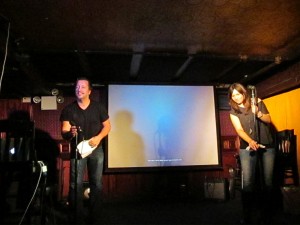
[Haspiel and Heller host the salon]
Though the salon opened to a full basement venue, audience members probably didn’t know quite what to expect from NIGHT JOB, however they might have known some of the performers by reputation. The term “salon” often implies multiple genres in the mix, and NIGHT JOB presented quite a range. Though each of these types of performance have the potential to be very entertaining on their own, it’s a challenge to combine them and create a sense of a cohesive event that, collectively, develops its own personality. NIGHT JOB found its way by emphasizing the raw power of very personal content from its salon members.
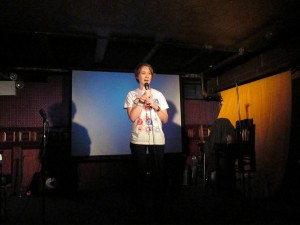
[Molly Knefel]
Knefel opened with a stand-up routine spoofing the “war on women” in congress last autumn, pointing out that a “war on anuses” would have had even the most conservative public official scrambling to sign up in protest. Her rapid-fire delivery and observational humor had the audience engaged from the outset, but her sense of personal commitment to the subject matter as a thinking person translating impressions of a bizarre world set the tone for the evening.

[Katharine Heller]
Heller read a selection from her recent project featuring “erotica” geared toward Republican sensibilities, “Tickle the Elephant”, and ingenious attempt to get inside the minds of what appeals to conservative women particularly. Turning the lingo of the senate floor and government catchphrases into turn-ons relentlessly, Heller narrated from the perspective of a conservative seduced by liberalism into a sexual common ground. Heller revealed a rather in-depth knowledge of politics on both sides of the party schism in her artistry, and in her mix of satire and humor, suggested dialogue is possible even in the most heated debates.
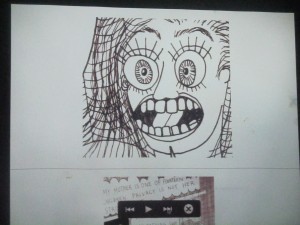
[A Turbitt comic panel]
Turbitt presented and performed a wide range of indie comix that appear online, increasingly irreverent to social taboos, particular in expressing women’s lives. From bathroom scenes of an intimate nature to things that most people find adorable but only annoy her, she pushed the envelope on expression and used the comic-panel reveal for shock-value. Her autobio approach struck many of the same chords as Knefel and Heller’s performances, bringing out the sense that discussing deeply personal subjects is still one of the most direct ways to reach an audience, who may be surprised to find out how much they have in common with the stories they hear and see.

[Meghan Turbitt]
Haspiel’s comix performance of “Awful George” from his series STREET CODE took the audience deep inside the strangeness, and the horror of urban stories, reflecting his own autobiographical reaction to witnessing a make-shift attempt to save a hoard of cats that had been wilfully neglected in an apartment, only to be topped by the discovery of a mummified corpse, begging the question, “How do you deal with these kind of realities?”
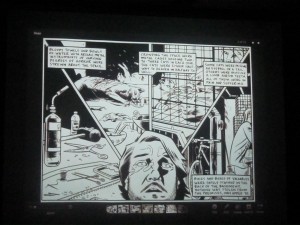
["Awful George" panel by Haspiel]
The answer from Haspiel is clearly “by expressing them and reaching out to readers”. His debut performance of a newly created Tommy Rocket comic, a spin-off from his BILLY DOGMA web comix, spoke to the twisted aspects of love, and the realities of failure and regret. Haspiel never pulls any punches in his comics, autobio or not, and these hammered home the role of authenticity in performance; getting up in front of a crowd to read your comics demands a kind of soul-baring stance that hits home for the audience.

[Dean Haspiel]
Reverend Jen took soul baring to a whole new level by reading from her unpublished novel, memoirs of her life as a prostitute attempting to support her artistic endeavors as a painter. She’s known for her extreme honesty during readings, and her narrative plumbed the depths of tragedy and suffering possible in what seems like an everyday world. Her description of images, as well as emotions, made for a stellar performance of prose. Rev Jen’s motivation in performing, to “get stuff out” of oneself actually also served the function of engaging the audience emotionally and reminding them, perhaps, of human resilience along the way.

[Rev Jen]
Angry Bob, true to his moniker, took on the role of voicing, like Knefel, Heller, and Turbitt, many of the things that people think, but don’t say out loud for fear of being ostracized as freakish. The truth, of course, is that they are not alone and everyone is wonder what’s considered “acceptable” to think or say in social settings. He described himself as someone “rooting through the garbage for shiny objects” like a racoon or other scavenger, and the objects he held up for inspection at NIGHT JOB were the ludicrous aspects of Reality TV, the curse of failed opportunities, and the general rage-inducing capabilities of young children, particularly in public. Angry Bob’s signature delivery, a high-octane rant that frequently addresses audience members directly, had their equally signature outcome: inspiring absolute hilarity at NIGHT JOB.

[Angry Bob]
The evening’s performances closed with the strikingly independent tones of Two Beards One Heart which also managed to match the ambiance of the previous salon members’ presentations. Not just in musical composition, whose sounds were so original as to suggest that the “personal” can be evoked as equally in sound as in words and images, but also in lyrics, Two Beards managed to create their own singular message.
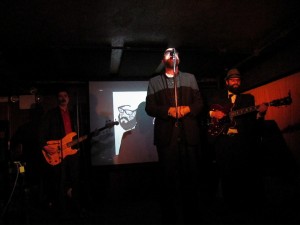
[Two Beards One Heart]
Their first song illustrated rising angst through lyrics despite its melodic construction, while the second contrasted the poetic, upbeat aspects of love with bigger realities and banal conflicts. Burandt’s vocals, far from predictable, were particularly engaging, and contributed to a sense of individualistic expression of life’s perplexing highs and lows.

[Jeffrey Burandt]
One of the most winning aspects of NIGHT JOB, aside from his cohesion as a salon of the personal made public, was the fact that Haspiel asked, repeatedly, if anyone else would like to perform their work, friend or stranger alike. It suggested an open-door to artists of any genre who also had something to share. The tone of the evening, celebrating unique perspectives with communal implications, was as well suited to comics as music and comedy.

[Haspiel delivers an open invitation]
Setting comics alongside other genres in performance is not a new practice, but it’s becoming increasingly popular, perhaps because of the rise of self-publishing and internet sharing of creative work. As comics find their footing among other artistic modes, it’s appropriate to start asking what comics have in common with other formats of expression, and what makes them particularly powerful for self-expression. NIGHT JOB did an excellent job of illustrating the point. Performance art forms are about a meeting of minds between the performer and the audience, and many genres already push the boundaries of inter-personal communication, comics included.

Hannah Means-Shannon writes and blogs about comics for TRIP CITY and Sequart.org and is currently working on books about Neil Gaiman and Alan Moore for Sequart. She is @hannahmenzies on Twitter and hannahmenziesblog on WordPress.
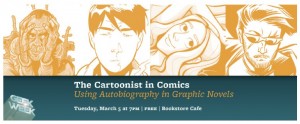
Autobiographical comics used to be a feature of zines and small private presses, but readers are increasingly able to follow their favorite genre of the comics medium in graphic novel editions from mainstream book publishers. There’s no doubt that the artistic appreciation for autobiography and semi-autobiographical works is on the rise, but amid commentary on layouts, designs, and narrative choices, it’s easy to lose touch with the personalities behind the works and the often difficult waters they navigate to create their comics. At Housing Works Bookstore and Café in Soho, part of the Housing Works charitable organization benefitting those affected by HIV/AIDS and homelessness, four cartoonists weighed in on their life in comics on March 5th in a panel hosted by comics scholar and author Christopher Irving (LEAPING TALL BUILDINGS, GraphicNYC). The event formed part of “Geek Week” at Housing Works, with copies of speakers’ books donated by publishers for sale to support the charitable organization.
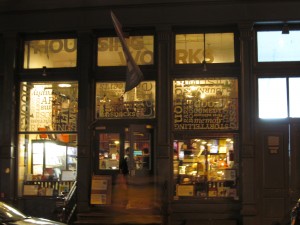
Panelists included Dean Haspiel (BILLY DOGMA, CUBA: MY REVOLUTION), Bob Fingerman (MAXIMUM MINIMUM WAGE, FROM THE ASHES), Laura Lee Gulledge (PAGE BY PAIGE, WILL AND WHIT), and Ethan Young (TAILS) and featured projected slides of their artwork along with readings, commentary, and discussion. Haspiel read “Dumbo” from his STREETCODE series, a tale of extensive personal injury after being “busted” as a thief by an overzealous and perplexed local driver during a film-shoot in Brooklyn and Fingerman read from an unpublished script of issue #11 of his acclaimed MAXIMUM MINIMUM WAGE series (which will appear in the new deluxe edition coming from Image March 20th) about the trials and tribulations of negative reviews and the dubious creative credits of working for “porno mags”. Gulledge, too, presented previously unseen material from her upcoming (in March) new book WILL and WHIT dealing with the stresses and awkwardness of teen life pursuing artistic expression, while Young read from his series TAILS, featuring cultural and familial clashes over relationships, but also noted that a second printed volume of the previously online series TAILS will be coming soon from Hermes Press.

Each of the cartoonists presenting their work engaged the audience on an emotional level in different ways, showcasing the versatility that makes autobiographical comics so popular. Haspiel’s comic narrated the already inherently absurd scenario of playing a thug in a friend’s film being chased by a costumed superhero an the equally absurd but downright serious impact of being mistaken for a real thief and being mown down by a would-be vigilante on set. Haspiel’s “DUMBO” focused on the psychological shock and mental processes handling the bizarre, and all too physically real situation.

Fingerman’s script handled his experiences working for a “rag” magazine in semi-autobiographical fashion through his avatar “Rob”, with an ear for frank and surprising dialogue between Rob and former co-workers on the subject of a bad review of his comics issued by a replacement writer in Rob’s own former column on the magazine. Through Rob’s dialogue, the audience could hear the character’s increasing fixation and personal struggle with the affront, while other characters commented irreverently on his overblown reactions. The emotions of the situation were powerful, even while comedic in tone.

Gulledge’s selection from WILL and WHIT used limited but realistic dialogue between friends to tease out the tensions in young adult conversations, anxiety in public performances (in this case a puppet show) and the supportive, but complicated role of group friendships. While Haspiel and Fingerman handled subject matter that may have been unfamiliar to many readers, but connected on the level of universal reactions to antagonizing situations, Gulledge presented a universal situation and explored it through the lens of different personality types.
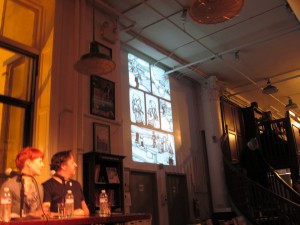
Young’s performance dealt with two major universal themes, family pressures and romantic relationships, but introduced the complicating factor of cultural divides as his character (also named Ethan) engaged in “blunt” conversations with his mother, translated from Cantonese into English, about whether dating a Chinese-American girlfriend was really the right thing for him. Each comics artist preserved a kernel of universal human experience in their works while bringing intricate detail of personal experience into the narrative to render it unique, compelling, and even more visceral. Experiencing the comics as performance, read by their creators, brought an added dimension of reality to the stories. Autobio comics readers often become fans of the “voice” of the cartoonist and feel that they almost know the author/artist personally, but this was a rare chance to hear the comic audibly and experience the comic visually with creator participation.

Christopher Irving took the opportunity to play readers advocate and encourage the panelists to explain how autobiography maps out the gray areas between art and life, asking what the relationship is, exactly, between these creators and their comic avatars. Gulledge explained that her characters are often “different variations” of sides of her personality, and in one of the most memorable phrases from the evening explained that portraying versions of herself in comics encourages her to take risks in expression, making her willing to “drop the baby” being thrown at her if necessary. The allusion was to a situation wherein street urchins might attempt to pick your pocket by throwing a doll at you, pretending it’s a real baby, in the hopes that you’ll be distracted enough to attempt to catch it. “Drop the baby” made for an excellent metaphor for autobiographical cartooning when the creator has to realize the difference between art and real life and take greater risks based on that truth.

Fingerman commented, to the audience’s amusement, that he would “gladly drop a baby”. His reasons for using an avatar named “Rob” rather than his own name, Bob, in MAXIMUM MINUMUM WAGE involved shying away from direct “narcissism” while keeping a certain “weight” of truth alongside the “latitude” for some fictionalization. Like Stephen Colbert’s concept of “truthiness”, he said, his comics get closer to the truth by allowing more freedom of expression than strict autobiography. He also added that after ten years of reflection on MAXIMUM MINIMUM WAGE and working on the new hardcover edition from Image , however, he’s “seriously thinking of coming back to the series and starting it up again”, which provoked a round of enthusiastic applause from the audience.
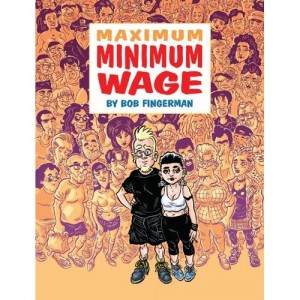
Haspiel’s own feelings about the difference between autobiographical and semi-autobiographical comics, two genres he has worked with extensively, pivot on his concern that autobiographical comics only allow the reader to act as “voyeur” in someone else’s life. Like Fingerman, Haspiel reflected on the fact that semi-autobiographical narratives enable the creator to zero-in on “emotional truths” that they might not be able to emphasize as fully when sticking purely to facts. His advice to autobiographical or semi-autobiographical cartoonists, generally, is to “get outside” and experience life, making sure you “show up to the party” that is life and take part in order to create compelling stories. Gulledge chimed in that she agreed with Haspiel and Fingerman, that even autobiographical comics are not about the cartoonists life in terms of their purpose, but are about “helping” the reader understand themselves by engaging with real-life situations.
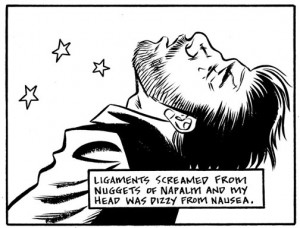
[Image from STREETCODE's "Dumbo" by Haspiel]
Young explained that he feels that his life can, in some ways, seem stereotypical, including his Asian-American heritage, emphasis on city narratives, his real-life situation of quitting college, and even being “self-indulgent” in writing stories designed to “get even” with an ex-girlfriend. But having a relatable life is certainly not a hindrance in autobiographical comics, especially when you capture the “romance” you see in the ordinary. Young hopes to “capture” some truths from his life in a memorable way, such as “living really broke” and “being single in New York”, experiences many readers might share. The most problematic thing Young has faced, he said, about working in autobiographical comics, is that readers equate the Ethan of his comics with Ethan in real life and feel free to tell him that he’s an “asshole” on a regular basis. He’s also been questioned for bringing “fantastic elements” into his works despite their overtly “realistic” tone, and like Haspiel and Fingerman, Young thinks a “metaphorical” element helps him “comment on how interconnected we are with our creations”. It seemed part and parcel of artistic freedom to branch from autobiography into metaphor for several of the panelists.

The discussion between comics artists on the panel was often freeform and interactive during the event, and they chatted about the increasing role of images online, the freedom the internet offers in terms of self-publication, and the impact that it has had on autobiographical comic production. Haspiel commented on the ways that social media has become a form of autobiographical expression, leading him further down the road of embracing metaphor rather than strict biography in his work. Even Gulledge expressed her movement toward “boiling down” life experiences to get to what life is “really about” due to the comparison between unedited and immediate self-expression on social platforms. Haspiel also noted, however, that social media opens up publicity options for web-based work, as in the case of ACTIVATEcomix, which he founded in 2006, and his currently curated multimedia arts site TRIP CITY. The very same technology that raises questions about autobiography by presenting human experience in an unfiltered way can serve as the platform for promoting the more focused works of art that reflect on life’s truths. One of the final topics of the evening focused on advice for cartoonists about funding and publishing their autobiographical and semi-autobiographical works. Now, more than ever, Haspiel argued for the need to be “be part of a community”, whether seeking crowd-funding or readership.

It was clear from hearing the panelists in discussion that they do form their own community of creators supporting many of the same goals in comics, and that each of them has a specific commitment to their readership in creating their work. The fact that the event spotlighting “the cartoonist in comics” not only benefited the comics community by exploring the role of biography and providing insights into creative process, but also raised funds for a worthy local charity emphasized the reciprocal role of community in supporting artwork about the significant truths hidden in everyday life and improving “real life” for those in need. The event was live-streamed by Housing Works and may be available in video format soon.

Hannah Means-Shannon writes and blogs about comics for TRIP CITY and Sequart.org and is currently working on books about Neil Gaiman and Alan Moore for Sequart. She is @hannahmenzies on Twitter and hannahmenziesblog on WordPress.































Beautifully written! This manages to capture how truly amazing the evening of performances was. Hope there are more salons like this one!